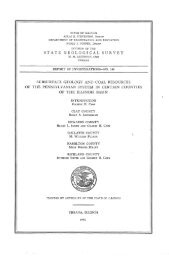Cu, Lu, <strong>and</strong> Sc than did the three western <strong>fly</strong> <strong>ash</strong>es. Similar trendsfor certain transitional metals have been reported elsewhere for <strong>ash</strong>esfrom eastern <strong>and</strong> western <strong>coal</strong>s.5. IJnder 1 aboratory conditions, the seven gray samples produced a1 kal ineextracts, whereas the two reddish <strong>fly</strong> <strong>ash</strong>es generated acidic extracts.Color may be useful in predicting the initial pH <strong>of</strong> a <strong>fly</strong> <strong>ash</strong> slurry orleachate in the field-6. The ratio <strong>of</strong> matrix CaO to SO3 may influence the pH <strong>of</strong> extractsduring the initial stages. Short-term acidic extracts were associatedwith samples having a CaO/S03 ratio <strong>of</strong> less than 2; alkalinesolutions were produced from samples having matrix CaO/S03 ratiosexceeding 2.7. The general trend <strong>of</strong> EP solubility for the Illinois Basin <strong>fly</strong> <strong>ash</strong>es wasfound to be S04-S > Ca, B > Cd > Sb, Mn, Mg > Zn > Na, Mo > K, Ni, Cr,Cu > Be, Ba, Si, Al, Fe. The general pattern <strong>of</strong> solubility for thesubbituminous <strong>fly</strong> <strong>ash</strong> was S04-S > B > As > Ca > Se > Mg, Zn > Mn > Na> K, Ba, <strong>and</strong> for the two lignite <strong>fly</strong> <strong>ash</strong>es, S04-S > 6 > K, Mo >> Se,Na > Ca > Zn, Mg > Be, Cr > Mn, Si, Ba.8. Although all <strong>fly</strong> <strong>ash</strong>es are currently exempt from the list <strong>of</strong> hazardouswastes under RCRA, EP data indicated that one <strong>of</strong> the 12 samples wouldbe classified as a hazardous waste by present criteria. One acidic <strong>fly</strong><strong>ash</strong> contained enough soluble Cd to classify it as a hazardous waste ifthe status <strong>of</strong> <strong>fly</strong> <strong>ash</strong> as a nonhazardous waste were to be revised.9. In long-term equilibrations (100-140 days) <strong>of</strong> five <strong>fly</strong> <strong>ash</strong> samples, theconcentrations <strong>of</strong> several potential pollutants began to decrease almostimmediately after the first day <strong>of</strong> extraction, <strong>and</strong> this decreasecontinued for 60 to 120 days until steady state conditions developed.The pH <strong>of</strong> the acidic extracts became neutral after about 3 to 5 weeks<strong>and</strong> consequently several potential pollutants were less soluble in theresulting nonacidic solution. In all five long-term equilibrations,several constituents reached a metastable equilibrium, persisting atinvariant concentrations for the latter part <strong>of</strong> the extractioninterval .10. The specific concentrations <strong>of</strong> some <strong>of</strong> the inorganic constituents inthe solutions (prior to equilibration <strong>and</strong> after steady state conditionsdeveloped) exceeded the EPA interim primary or secondary drinking waterst<strong>and</strong>ards <strong>and</strong> irrigation water cri teri a.11. Organic compounds identified in the <strong>fly</strong> <strong>ash</strong>es were only slightlysoluble in the aqueous extracts. Although some <strong>of</strong> the organics presentin the samples are on the priority pollutant list, they are present insuch low concentrations that it is doubtful that they would pose anysignificant environmental problems during l<strong>and</strong>filling operations orpond i n g .12. Fly <strong>ash</strong>es--particularly acidic types--are probably most toxic toaquatic ecosystems when initially slurried to disposal ponds; theirtoxicity may decrease with time. If the potential contaminants achieve
steady state conditions in the disposal pond, they may have longresidence times in the <strong>ash</strong> effluent, thus increasing the probability <strong>of</strong>bioaccumulation by aquatic organisms.13. Of the 12 <strong>fly</strong> <strong>ash</strong> samples evaluated, five were selected for toxicitytesting on the basis <strong>of</strong> the diversity <strong>of</strong> extract pH values observed.All five extracts were acutely toxic to fathead minnow fry.14. Physicochemical components probably responsible for the acute toxicity<strong>of</strong> the <strong>fly</strong> <strong>ash</strong> extracts to fish were pH, Al, ionic strength, <strong>and</strong> Zn.Because <strong>of</strong> the complex composition <strong>of</strong> some extracts <strong>and</strong> the unknownsynergistic <strong>and</strong> antagonistic effects <strong>of</strong> the chemical constituents <strong>of</strong>the extracts, it was not possible from these experiments to determinewhich chemical constituents specifically were responsible for theobserved mortality.15. The <strong>fly</strong> <strong>ash</strong> extracts were diluted to levels presumed subacutely toxicfor use in bioaccu~nul at ion experiments. The growth <strong>of</strong> fathead minnows<strong>and</strong> green sunfish exposed to these diluted <strong>fly</strong> <strong>ash</strong> extracts was notsignificantly different from that <strong>of</strong> control test organisms exposed t<strong>of</strong>iltered tap water under similar conditions.16. The fathead minnows <strong>and</strong> green sunfish accumulated similar elements fromthe <strong>fly</strong> <strong>ash</strong> extracts; the six chemical constituents most commonlyaccumulated from <strong>fly</strong> <strong>ash</strong> extracts were Al, B, Cd, Mn, Mo, <strong>and</strong> Ni. Ofthese six chemical constituents, Cd appeared to be <strong>of</strong> greatestimportance because <strong>of</strong> its highly toxic nature.1. An apparent relationship was observed between the initial pHcharacter <strong>of</strong> a <strong>fly</strong> <strong>ash</strong> leachate <strong>and</strong> its color <strong>and</strong> the matrixCaO/S03 ratio in the solid waste. Further study <strong>of</strong> the less commonlyproduced acidic high-iron <strong>fly</strong> <strong>ash</strong>es should be done.2. The long-term equilibration (LTE) extraction procedure was designed tosimulate equilibrated <strong>ash</strong> ponds. Although obtaining representative pondsamples is difficult, such field work should be done to assess theaccuracy <strong>of</strong> the LTE procedure.3. Fly <strong>ash</strong> laboratory extracts <strong>of</strong>ten undergo complex changes in chemistrywith time <strong>and</strong> should be studied to determine which mineral phasescontrol the aqueous solubility <strong>of</strong> the components. The chemistry <strong>of</strong>slurry water <strong>and</strong> disposal ponds should also be studied <strong>and</strong> modeled todetermine whether the same types <strong>of</strong> changes that occur in laboratoryextracts occur in the field,4. Grab samples were collected from only nine power plants, seven <strong>of</strong> whichwere in Illinois. To provide a more complete picture <strong>of</strong> <strong>fly</strong> <strong>ash</strong>composition <strong>and</strong> variability, samples from other Illinois power plants<strong>and</strong> from other states should be studied.5. The scope <strong>of</strong> the ecological analyses <strong>of</strong> <strong>fly</strong> <strong>ash</strong> in this study consisted<strong>of</strong> acute static bioassays using fathead minnow fry <strong>and</strong> bioaccumulation
- Page 1 and 2: lllinoiSTATSTAT
- Page 3 and 4: V SURVEYatural Resources Building60
- Page 5 and 6: TABLESSummary of the origin and gen
- Page 7: The overall purpose of this investi
- Page 11 and 12: total carbon determinations were ca
- Page 13 and 14: y passing the extract through a col
- Page 15 and 16: The GC-MS analyses were performed b
- Page 17 and 18: with ultrapure water. The final HCl
- Page 19 and 20: Be 3. Wlir~eraiogical composi'tion
- Page 21 and 22: Table 6. Trace constituent concentr
- Page 23 and 24: Table 7. Fly ash sample classificat
- Page 25 and 26: Table 8. Carbon, sulfur, and benzen
- Page 27 and 28: Wave number (cm-'Figure 8. Infrared
- Page 29 and 30: Figure 12. HPLC chromatogram of the
- Page 31 and 32: Figure 16. HPLC chromatogram of the
- Page 34 and 35: Table 11. Organic components in the
- Page 36 and 37: Figure 21. Gas chromatogram of the
- Page 38 and 39: 4.Jrcrm c o mQU"* 'tn U.a-U U O NrO
- Page 40 and 41: constituents. The amount of soluble
- Page 42 and 43: Table 14. Change in chemical compos
- Page 44 and 45: Table 16. Change in chemical compos
- Page 46 and 47: Change in chemical composition as a
- Page 48 and 49: Figure 26. Changes in the concentra
- Page 50 and 51: Table 19. Corytituents in the long-
- Page 52 and 53: Table 21. The LC-50 values, amount
- Page 54 and 55: Table 23. The range of concentratio
- Page 56 and 57: Table 25. The range of concentratio
- Page 58 and 59:
Table 27. The mean initial lengths
- Page 60 and 61:
Table 32. The mean final lengths an
- Page 62 and 63:
Several of the extrbivalves ( ~ are
- Page 64 and 65:
The mean concentrations of various
- Page 66 and 67:
1972). Cadmium is a dangerous cumul
- Page 68 and 69:
Bl umer, M., 1957, Removal of eleme
- Page 70 and 71:
Furr, A. K-, T. F, Parkinson, R. A.
- Page 72 and 73:
Murtha, M. J., and G. Burnet, 1979,
- Page 74 and 75:
Standard methods for examination of
















